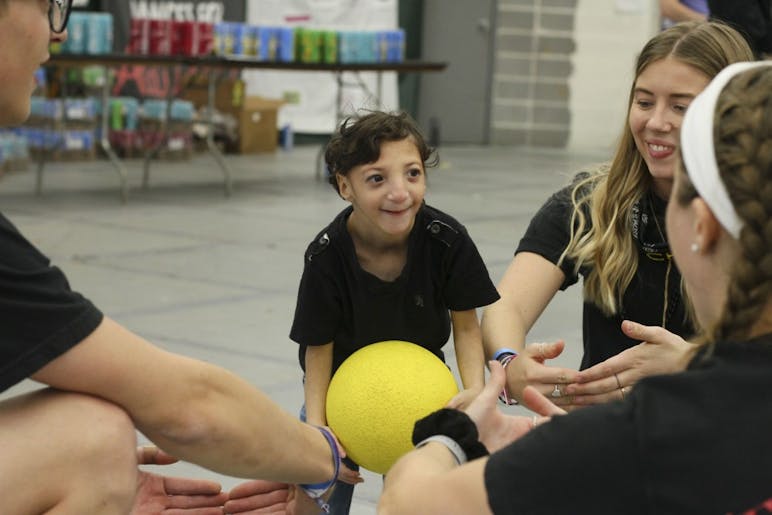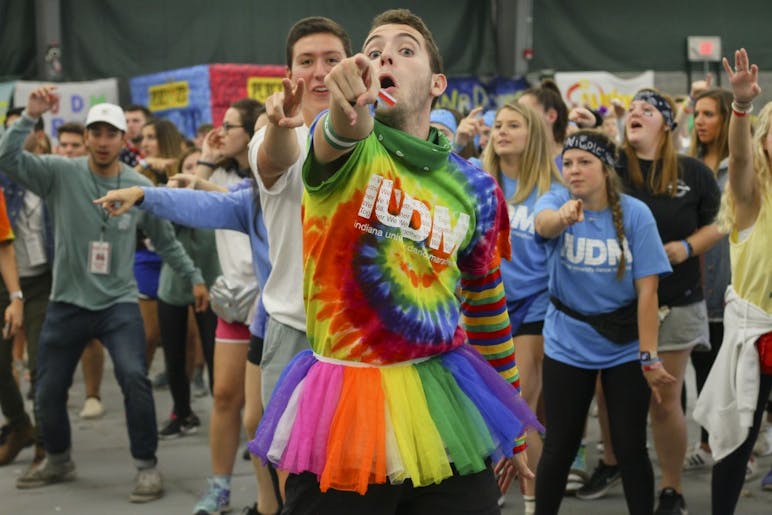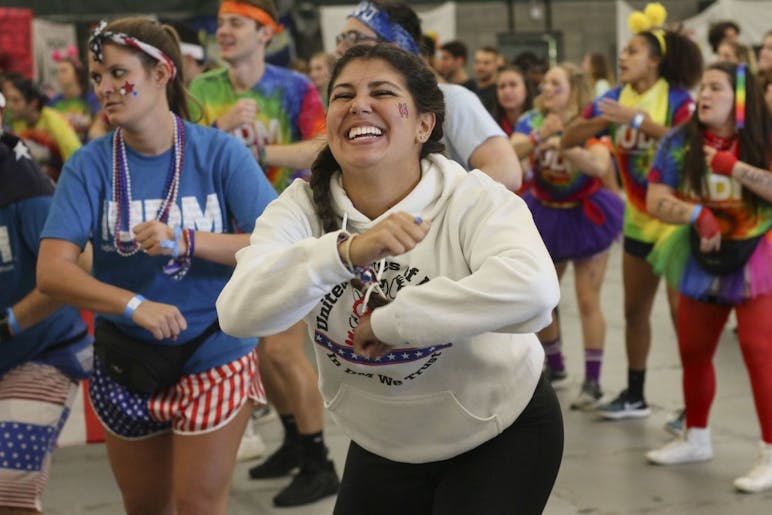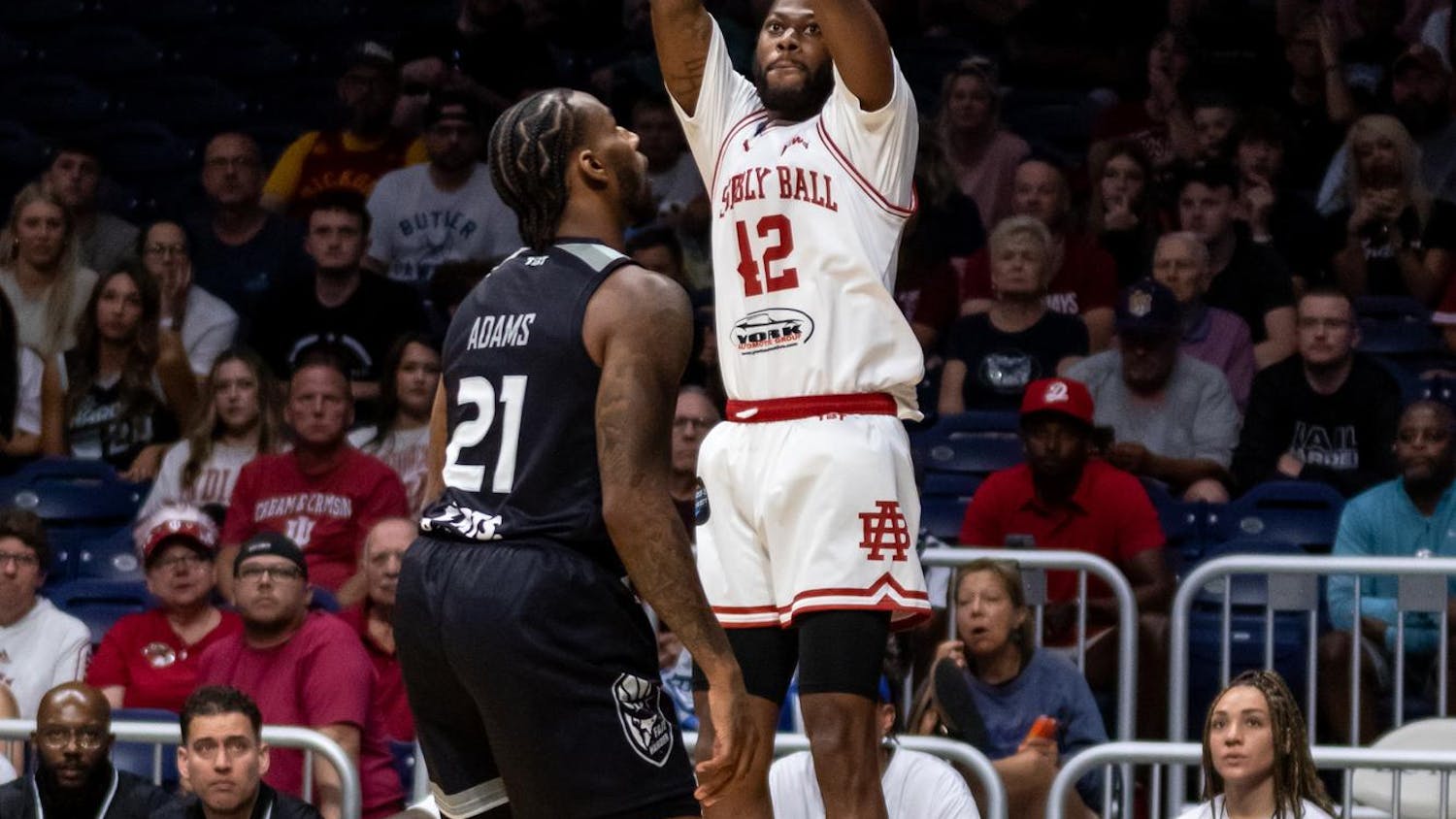IU Dance Marathon raised $4,187,051.23 during its 28th dance marathon. Participants danced for 36 hours from Friday night to Sunday morning while raising money for the Riley Hospital for Children at IU Health in Indianapolis.
The marathon featured families telling the stories of their children who have been treated at Riley Hospital for Children, live music, line dances and the dancers' rallying cry "FTK" or "For the kids," yelled throughout the event. Here's a look at the dance marathon's 36 hours.
Hour 0
IU Dance Marathon started off with dancers jumping around, bristling with energy and eager to dance. Shirts of all colors emblazoned with the letters IUDM fluttered around the room.
The participants have been raising money for months, through text messages, social media campaigns and door-to-door fundraising. Funds go to Riley Hospital for Children and Wells Center for Pediatric Research.
IUDM was started in 1991 by alumna Jill Stewart to honor her friend Ryan White. After White contracted AIDS from a blood transfusion, he became an AIDS activist. He died four and a half months before he could come to IU to start his freshman year.
Since starting the organization 27 years ago, IUDM has become one of the largest student-run philanthropies in the nation.
Hour 16
A dozen dancers stood in a circle, their shoes lying in the center, as they clapped, chanted and danced.
“Don’t Stop Believing” blared, making it almost impossible to hear anything else. Hundreds of students in T-shirts, tutus and superhero capes sang along.
Three families, each with a child treated at Riley Hospital for Children, walked onto the stage as the music softened and dancers crowded around.
Alexis Mata told the story of her son, Adrian Mata. When Alexis Mata was pregnant, her fetus was growing too slowly and doctors told her it would be a miracle if she made it to 27 weeks of pregnancy. She was induced at 39 weeks and gave birth to a three-and-a-half pound baby boy after 40.5 hours of labor.

Adrian Mata had a heart condition and stayed in the neonatal intensive care unit. Doctors told Alexis Mata her son would need an open-heart surgery soon or he would die, but no one wanted to perform the surgery because they believed the boy’s quality of life would be very poor if he lived, she said. They thought he would never be able to walk, talk or feed himself.
At six-and-a-half weeks old, Adrian Mata was moved from the NICU to hospice care, where he was expected to die within days. He stayed in hospice for a few months, where doctors eventually diagnosed him with primordial dwarfism.
Finally, Riley Hospital for Children agreed to perform Adrian Mata’s open-heart surgery. Now he’s 4 years old and hasn’t stayed in a hospital since.
Dancers snapped, cheered and cried as the Matas and other Riley families told their stories.
In 30 minutes, dancers raised another $14,000.
19 hours to go.
Hours 28 to 30
As the hours trudged on, students who danced for 36 hours faced the second night of no sleep.
Some stood around, eyes glazed over with dark circles under their eyes while others were still dancing and screaming.
At midnight, student Jack Duffy ran onto the main stage, full of excitement and energy, ready to teach one of the groups a line dance.
Some dancers even practiced the dance while taking their break to eat pizza.
“We’ve been learning the line dance over and over again,” freshman Rae Nourie said. “We really want to nail it.”
In one corner, an inflatable jail was set up. Inside were a few dancers, vigorously typing on their phones trying to get donations. Standing around it were students wearing cop hats.
Kat Riddell, member of the entertainment committee, said when dancers get a donation, they can choose to arrest other dancers. That dancer has to stay in the jail until they raise enough money to match that donation amount.
As the clock moved back and 1 a.m. started for a second time because of daylight saving time, students hardly seemed phased by the extra hour they would spend on their feet.
At 1:20 a.m., it was time for the rave.
As the overhead lights flicked off, the room was lit only by glow sticks.
Even though many students' voices were raw from talking over the music the whole weekend, they screamed as the DJ and entertainment crew stormed the stage.
“We could do this all night,” the crowd echoed to the Icona pop song "All Night."
And they did.

Hour 36
The dancers waited expectantly, shifting around and trying to keep their energy after dancing for more than 35 hours.
Alumni slowly filtered in, branded with shirts of past dance marathons with slogans from as early as 1991. The shirts from 1991, the inaugural year, read “Celebrate life. Dance. Hope.”
Dancers gathered in a circle, holding onto each other’s hands, shoulders and waists. The building could barely fit the more than 1,400 dancers in the room. The participants swayed back and forth as “Angels Among Us,” by Alabama, played.
Dancers chattered and looked toward the stage, waiting for the total to be revealed. The accounting committee filled the stage with numbers scrawled on poster boards. FTK, or For the Kids, was shouted across the room.
IUDM raised $4,187,051.23 during its 27th dance marathon, a long way from the $10,900 the organization raised in 1991. The final total is about $16,200 less than last year.
The total was announced and, the room erupted with noise. Screams and cheers of joy echoed inside the building as dancers celebrated.
As the marathon came to an end, people continued to shout “For the Kids” as a rallying cry while dancers jumped in misshapen circles.

A previous version of this story incorrectly stated IUDM raised $4,187,051.22, this was the 27th annual IUDM and that the board of directors raise the total at the end. IUDM raised $4,187,051.23, this was the 28th year and the accounting committee raised the total at the end.The IDS regrets these errors.




